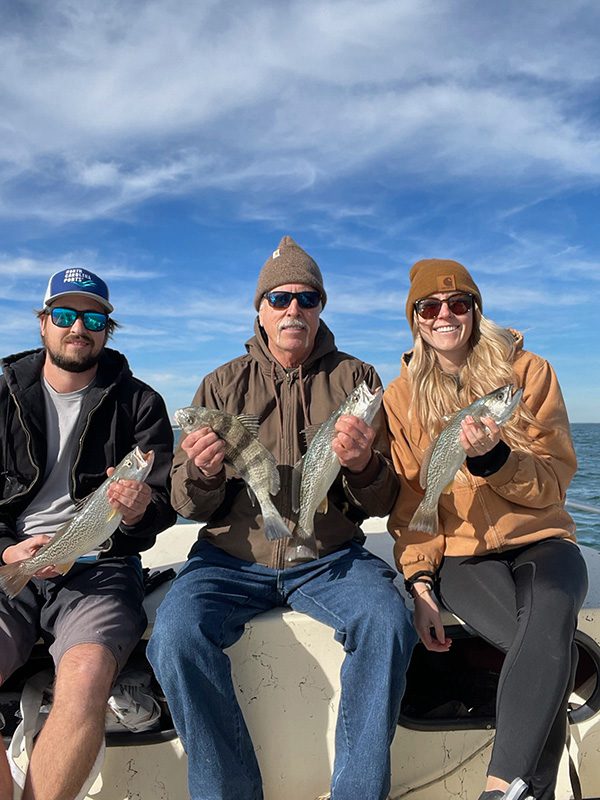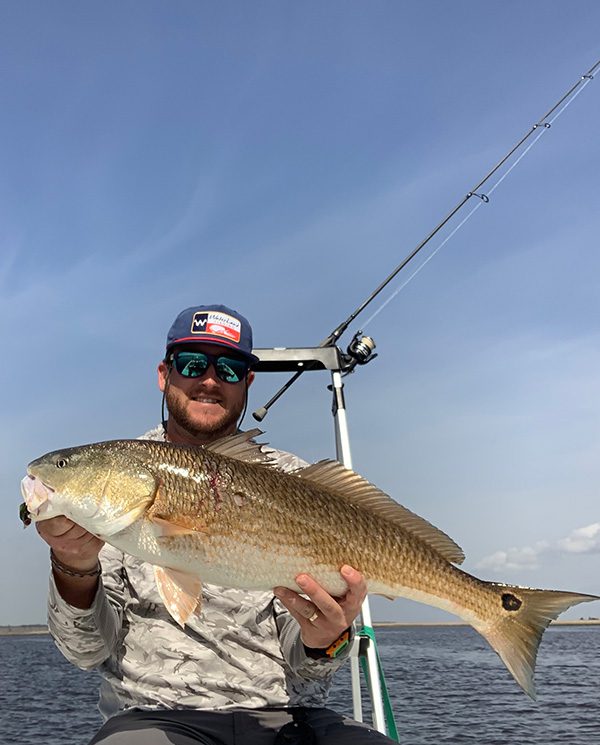Carolina Beach – March 2023
Lewis, of Island Tackle and Hardware, reports that anglers anticipate better numbers of whiting to start arriving in the area as water temperatures get into the upper 50s. Bottom rigs with bait shrimp are all that is needed for this action in the surf, deeper holes around the inlet, and down around the mouth of the Cape Fear River.
In addition to whiting, surf anglers could also start seeing smaller flounder in the coming weeks.
Red drum are being found just about everywhere in the creeks and marshes of the Cape Fear.
Speckled trout are mixed in the action, but look for the trout to really pick up moving into the later stretches of March and into April.
Sheepshead and black drum will pick up soon when both species start pushing back inshore and staging up around areas of hard structure.
Christian, of Seahawk Inshore Fishing Charters, reports that there are a few schools of red drum staged in the shallow areas back in the creeks and bays. These schools have mostly been smaller than some of the typical large winter schools, so don’t expect huge numbers and prepare to keep on the move when coming across a bite. A variety of baits will trigger strikes when finding them, including live mud minnows, dead shrimp, and lightly weighted soft plastics.
There are some black drum around as well, and they are mostly holding tight to inshore hard structures and feeding on dead shrimp.
Luke, of Spot On Charters, reports that the speckled trout action should really start ramping up moving further into March. When fishing in these cooler months, utilizing smaller artificial baits such as MirrOlure MR-17s or 3” soft plastics are better options, as the lethargic fish don’t want to metabolize a large meal. With water conditions on the clearer side, darker baits will have the better successes.
Red drum fishing has been pretty good down in the marshes around Bald Head and Snows Marsh for anglers fishing the same lure setups.
The striped bass action upriver has been steady all winter.
Tommy, of Mungo Fishing Charters, reports that anglers this time of year are focusing much of their efforts on red drum fishing. For this flats-based fishing, it is best to look for the good weather days with very little winds to be able to search these flats. On the higher tides, scout the grass banks, whereas on lower tides, look off the banks in the wide bays or channels. These winter reds are holding in big schools, so understand there can be a lot of seeking to find this moving target.
Red drum can also be found by casting dead shrimp around oyster bars and deeper holes in the backs of mainland creeks. This tactic also provides a great opportunity to hook into black drum that are staged in these same creek holes.
Mason, of Grand Slam Fishing Charters, reports that the red drum fishery is the main focus, and anglers are mostly finding them holding in shallow waters. Searching and covering water on the lighter wind and sunny days is best accomplished with Gulp or Z-Man soft plastics, and having these baits very lightly weighed will keep from spooking these schools that sit on the shallow flats. A long cast is another tactic that increases the chances of a strike.
Anglers fishing the striped bass bite upriver have found some red drum mixed in the action. Both these species are staged up on ledges with good structure. Getting above the structure and vertical jigging will help to prevent hang ups and provide a good presentation to these fish.
Black drum are also staged up on ledges throughout the river. A Carolina-rigged shrimp cast on these drop-offs in the 4-8’ range is a good starting point for targeting black drum.
Rod, of OnMyWay Fishing Charters, reports that Atlantic bonito are already starting to be found out over deeper structures to the north of our area, a sign they could be pushing in early over the coming weeks. Anglers need to be ready to target days where there are lighter west winds and water temperatures in the 58-65 degree range.
Black sea bass fishing has been nothing short of phenomenal, and this continues throughout March. Anglers are finding such a large number of quality fish that there is hardly any reason to keep anything other than a jumbo (20”+ range). Ledges and live bottom in the 80’ range have been a great area to target.
King mackerel are also moving around offshore and holding on areas with those 69-70 degree water temperatures. Trolling Drone spoons or false albacore belly strips will work well when fishing these prime water temperatures.
Runs out to the break are producing some good wahoo and blackfin tuna action. There is also a bunch of false albacore out there, and anglers need to get their baits deep to help raise the chances of hookups from the target species. The bigger Yo-Zuri or DTX Minnows pulled at 6-9 knots can help achieve the desired look in the spread.
Lex, of Hunt Riggs Charter Company, reports that nearshore action is all about the black sea bass bite in these cooler winter months. These are a great target for anglers looking to get out on the water, and they almost guarantee some catching action as they are aggressive feeders.
With the mild winter conditions, it might not be long until the Atlantic bonito start showing up. Hard-fighting false albacore also tend to arrive right around the same time.
There are some sheepshead out on the nearshore wrecks, but many anglers look forward to warmer water starting to push this fish back inshore.
Offshore action is a bit light as anglers hold out for the favorable weather windows. There are some scattered wahoo and blackfin tuna around, but many wait for the first push of large mahi to move through before really focusing efforts offshore.


